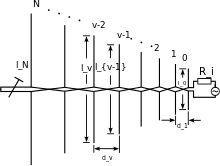Logarithmic periodic antenna
A logarithmic-periodic antenna , abbreviated to LPDA for logarithmic-periodic dipole antenna , also known as a logper for short , is a broadband antenna that consists of a number of dipole antennas whose length and distance decrease towards the direction of radiation.
The specialty of the LPDA lies in its broadband nature with simultaneous directional effect . LPDA combine the advantages of conventional narrowband Yagi antennas and broadband butterfly antennas . The achievable antenna gain is, however, below the Yagi antennas of the same size. The log-periodic antenna was developed in 1957 by Raymond H. DuHamel and Dwight E. Isbell.
Layout and function
LPDA can be built from wires, solid rods or in the form of conductor tracks on an insulating plate, which are excited via a line connecting all elements. The feeding line can consist of a strip line , a ribbon line or the support beams: Here dipole elements are alternately attached to two parallel beams (so-called booms ) in the longitudinal direction of the antenna at certain intervals. LPDAs thus consist of a spatial sequence of elongated dipoles that are crossed with an electrically conductive connection between each elongated dipole in order to excite the dipoles in the correct phase.
The essential criteria for dimensioning the logarithmic periodic antenna are two geometry parameters:
- The spatial distance between the individual dipoles, which is a logarithmic function and is the name given to this antenna design. This distance decreases towards the tip of the antenna.
- The length of the individual dipole elements. The length also decreases towards the tip, which results in a triangular shape in broadband antennas when viewed from above on the contour of the antenna.
The feed point of the LPDA is at the tip of the antenna near the smallest element. The high-frequency wave traveling back on the exciting line finds the matching dipoles that are in resonance and is primarily emitted there. The shaft is only insignificantly influenced by the elements in front of it that are too short. LPDA have an even antenna gain over a large frequency range and also good impedance matching. Even without parasitic elements acting as reflectors or directors, LPDAs achieve a high front-to-back ratio (VRV). In some cases, additional reflectors are used to improve the VRV at low frequencies. Supervisors improve the antenna gain at high frequencies.
By varying the gradient of the element spacing and length, both extremely broadband LPDA with lower gain and less broadband LPDA with higher gain can be produced. The antenna gain also depends on the number of dipole elements. It is around 6 dB to 10 dB.
Applications
Applications are in broadband communication , as television reception antennas, since the corresponding antennas can work in the ultra-short wave (VHF) as well as in the decimeter wave (UHF) range, for measurements of electromagnetic compatibility (EMC) in test laboratories, for military and civil radio communication such as amateur radio and as a mobile application on direction finders to locate radio interference.
A slightly modified version of the logarithmic-periodic antenna can also be found in event technology. They are used for radio microphones and, in the opposite direction, for wireless in-ear monitoring, as the directional effect (approx. 100 °) amplifies the signal. That is why the antenna is also called a directional antenna or paddle antenna in VA technology.
literature
- Gerd Klawitter: Antenna advisor receiving antennas for all wave ranges. 6th edition. Verlag für Technik und Handwerk, Baden-Baden 2005, ISBN 3-88180-613-X .
- John D. Kraus , Ronald J. Marhefka: Antennas for all applications . 3. Edition. McGraw-Hill, 2002, ISBN 0-07-112240-0 .
Web links
- Development of a logarithmic-periodic dipole antenna
- Homemade logarithmic-periodic duoband dipole antennas
- Stacked logarithmic-periodic antennas (PDF, 899 KiB)
- Logarithmic Periodic Dipole Antenna Calculator
Individual evidence
- ↑ Raymond H. DuHamel, Dwight E. Isbell: Broadband logarithmically periodic antenna structures. In: IRE International Convention Record, 1957, pages 119-128.
- ^ The Log-Periodic Dipole Array. Retrieved January 8, 2015 (PDF).

